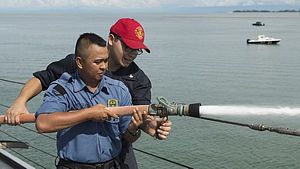This week, the United States and Brunei kicked off the latest iteration of an exercise between them. Though the drills themselves were just the latest interaction between the two sides, it nonetheless put the focus on some of the ongoing activity within the broader defense relationship between them.
As I have observed previously in these pages, the United States and Brunei have a defense aspect to their overall bilateral relationship, which includes various bilateral components such as ship visits and exchanges, along with other wider multilateral components as well such as the Southeast Asian state’s involvement in the Cooperation Afloat Readiness and Training (CARAT) exercise. Both sides have continued to try to develop the defense relationship still further over the past few years.
That has continued on over the past year or so. Just last August, we witnessed a new development in the bilateral relationship with the holding of Exercise Pahlawan Warrior under the segment of Pacific Pathways, which constituted the first bilateral training exercise of its kind between the armies of the United States and Brunei. And visits have continued on into 2019 as well, with a recent notable case in point being the introductory trip to Brunei by INDOPACOM chief Philip Davidson back in September since he assumed his post in May 2018.
This week, the defense aspect of the relationship was in the spotlight again with the holding of this year’s iteration of the CARAT exercise between the United States and Brunei. The exercise between the Royal Brunei Armed Forces (RBAF) and the United States Navy (USN) and United States Marine Corps (USMC) kicked off in Brunei on October 22 following planning conferences that the two sides had held earlier this year.
The exercise, which lasts until October 31, consisted of several components. Per Brunei’s defense ministry (MINDEF), this included a legal symposium, a women’s interaction program, senior enlisted engagement, a harbor phase, and a sea phase. A number of activities were also held before the opening ceremony, including a land phase, a medical symposium, and force protection training.
According to MINDEF, participating forces this year included the U.S. Navy and U.S. Marine Corps on the U.S. side as well as various units from Brunei, including the Royal Brunei Land Force, Royal Brunei Navy, Royal Brunei Airforce, the Military Police, Judge Advocate General’s Office, RBAF Medical Services, the RBAF Band, and Public Relations Unit. On the Brunei side, other government agencies such as the Royal Brunei Police Force, Maritime Port Authority Brunei Darussalam, Fisheries Department, Narcotics Control Bureau, Attorney General’s Chambers, Emergency Medical Ambulance Services (EMAS) and University Brunei Darussalam are also participating as well.
This year’s CARAT held additional significance since it marks 25 years that the two sides have been holding the exercise. And both sides highlighted aspects of the exercise that were of particular note, with the U.S. Navy noting in a statement that for the second time in a row, the commander of Task Force 73, Joey Tynch, had flown a Sikorsky S-70i Black Hawk helicopter at Rimba Air Base on October 22 alongside Royal Brunei Air Force chief Muhammad Walee Bin Haji Rosli. The U.S. Navy said that the flight, which consisted of simulated tactical maneuvers and combat landing practice in a remote jungle environment, was a tangible demonstration of efforts to strengthen the close defense partnership and mutual commitment to the CARAT exercise series.
Apart from the exercise, both sides also had other interactions that were tied to the defense relationship as well. For instance, according to MINDEF, Tynch paid a courtesy call to the commander of the RBAF in conjunction with the exercises. During their meeting, both sides discussed the close military ties between their two forces and also explored more interactions in the future, in an engagement that further reinforced the state of their security relationship.
































